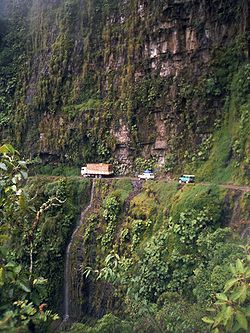Yunga
| Yungas | |
|---|---|
| Natural region | |

Yungas Road in Bolivia
|
|
 Vegetation of Peru. Mountain rainforest in blue-green. |
|
| Country | Peru, Bolivia and northern Argentina |
The Yungas (Aymara yunka warm or temperate Andes or earth, Quechua yunka warm area on the slopes of the Andes) is a narrow band of forest along the eastern slope of the Andes Mountains from Peru, Bolivia, and northern Argentina. It is a transitional zone between the Andean highlands and the eastern forests. Like the surrounding areas the Yungas belong to the Neotropic ecozone and climate is rainy, humid, and warm.
The Yungas forests are extremely diverse, ranging from moist lowland forest to evergreen montane forest and cloud forests. The terrain, formed by valleys, fluvial mountain trails and streams, is extremely rugged and varied, contributing to the ecological diversity and richness. A complex mosaic of habitats occur with changing latitude as well as elevation. There are high levels of biodiversity and species endemism throughout the Yungas regions. Many of the forests are evergreen, and the South Andean Yungas contains what may be the last evergreen forests resulting from Quaternary glaciations.
The World Wide Fund for Nature has delineated three yungas ecoregions along the eastern side of the Andes:
Yungas are transitional zones between the Andean highlands and the eastern forests. The yungas forests are extremely diverse, ranging from moist lowland forest to evergreen montane forest and cloud forests. The terrain is extremely rugged and varied, contributing to the ecological diversity and richness. A complex mosaic of habitats occur with changing latitude as well as elevation. There are high levels of biodiversity and species endemism throughout the yungas regions. Many of the forests are evergreen, and the South Andean Yungas contains what may be the last evergreen forests resulting from Quaternary glaciations.
...
Wikipedia
